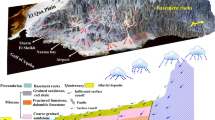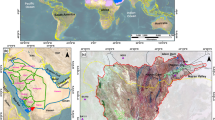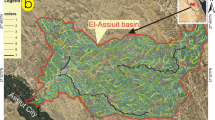Abstract
On November 25, 2009, heavy amount of rainfall precipitated in the city of Jeddah that led to floods causing unexpected loss of life (113 person died), and damaged public and private properties (10,000 cars were damaged/destroyed, and many houses, roads, highways, and industrial properties were also affected). The city of Jeddah is located within an independent mega drainage basin with a surface area of 1,760 km2. This mega basin is divided into three major sub-basins (northern, middle, and southern). Wadi Qus is located in the southern sub-basin with an area of ~63 km2. It passes through many of the neighborhoods such as Al-Harazat, Al-Sawaid, Queza, Al-Mesaid, Al-Haramin Highway, and the King Abdel Aziz University. These areas were severely damaged during the flash flood event in 2009. The current study deals with the determination of the best sites for the construction of flood control dams, followed by a number of detailed studies to ensure that these selected sites are appropriate. Geological, geotechnical, geophysical, and hydrological investigations were conducted to identify the types of rocks, the subsurface conditions, and the geotechnical properties of abutment and subsurface of soil and rock in the dam sites. The study found that there are three locations that can be appropriate for the construction of the flood control dams at Wadi Qus. Hydrological studies indicated that the runoff volumes for sub-basins B1, B2, and B3 are 2,102,709, 1,023,156, and 4,868,304 m3, respectively, for 500-year return period and 2,356,081, 1,149,687, and 5,451,123 m3, respectively, for 1,000-year return period. Comparing these values with the reservoir volumes calculated from the detailed ground survey with different dam’s height, it was found that dam’s heights of 15.5, 11.5, and 13.5 m for dams Q01, Q02, and Q03, respectively, are adequate for different basin volumes for 1,000-year return periods. Finally, the conceptual designs have been prepared and recommended for these dams.















Similar content being viewed by others
References
AccuWeather (2009) File name: November 25, 2009 Flooding, File Number: 120904, Courtesy of JDURC, Jeddah (KSA)
AlFugura A, Billa L, Pradhan B, Mohamed TA, Rawashdeh S (2011) Coupling of hydrodynamic model and aerial photogrammetry-derived digital surface model for flood simulation scenarios using GIS: Kuala Lumpur flood, Malaysia. Disaster Adv 4(4):20–28
Al Saud M (2010) Assessment of Flood Hazard of Jeddah Area 2009, Saudi Arabia. J Water Res Protection 2:839–847
Alehaideb S (1985) Precipitation distribution in the southwest of Saudi Arabia. Dissertation, Arizona State University
American Association of State Highway and Transportation Officials (AASHTO) (1986) Standard specifications for highway materials and methods of sampling and testing, 14th edn, 2 vols
Billa L, Mansor S, Mahmud AR, Ghazali AH (2006) Comprehensive planning and the role of SDSS in flood disaster management in Malaysia. Disaster Prevent Manag 15:233–240
Cunderlik JM, Burn DH (2002) Analysis of the linkage between rain and flood regime and its application to regional flood frequency estimation. J Hydrol 261:115–131
Elbialy S, Mahmoud A, Pradhan B, Buchroithner M (2014) Application of spaceborne synthetic aperture radar data for extraction of soil moisture and its use in hydrological modeling at Gottleuba Catchment, Saxony, Germany. J Flood Risk Management 7:159–175
Farajzadeh M (2002) Flood susceptibility zonation of drainage basins using remote sensing and GIS, case study area: Gaveh rod Iran. In: Proceedings of the international symposium on geographic information systems, Istanbul, Turkey, pp 23–26
Fowler, J (1989) The design and construction of small earth dams, appropriate technology, vol 3, no 4 (reprinted in Community Water Development, IT Publications, London)
Haeng HJ, Salas JD, Boes DC (2001) Regional flood frequency analysis based on a Weibull model, part 2 Simulations and applications. J Hydrol 242:171–182
Hansen KD, Reinhart WG (1991) Roller-compacted concrete dams. McGraw-Hill Inc, New York
Horritt MS, Bates PD (2002) Evaluation of 1D and 2D numerical models for predicting river flood inundation. J Hydrol 268:87–99
KACT (King Abdulaziz City for Science and Technology) (2011) Production of digital elevation model (DEM/DTM) with high resolution using stereoscopic satellite imagery and the deduction of drainage network and its direction and the water basins for Jeddah regions. Technical report, pp 1–62
Kia MB, Pirasteh S, Pradhan B, Mahmud AR, Sulaiman WNA, Moradi A (2012) An artificial neural network model for flood simulation using GIS: Johor River Basin, Malaysia. Environ Earth Sci 67:251–264
Lacroix MP, Martz LW, Kite GW, Jurgen Garbrecht J (2002) Using digital terrain analysis modeling techniques for the parameterization of a hydrologic model. Environ Model Softw 17(2):125–134
Merwade V, Cook A, Coonrod J (2008) GIS techniques for creating river terrain models for hydrodynamic modeling and flood inundation map**. Environ Model Softw 23:1300–1311
Moore TA, Al-Rehaili MH (1989) Geological map of the Makkah quadrangle, sheet 21D, Directorate General of Mineral Resources, Jeddah, Saudi Arabia, GM-107C, scale 1:250,000
Nelson KD (1985) Design and construction of small earth dams. Inkata, Melbourne
Peel MC, Finlayson BL, McMahon TA (2007) Updated world map of the Köppen-Geiger climate classification. Hydrol Earth Syst Sci 1:1633–1644
Portland Cement Association (2003) Design manual for small RCC dams, Publication EB 225.01. Prepared by Schnabel Engineering Associates Inc., Skokie, Illinois, USA
Pradhan B (2010) Flood susceptible map** and risk area delineation using logistic regression, GIS and remote sensing. J Spatial Hydrol 9:1–18
Pradhan B, Shafie M (2009) Flood hazard assessment for cloud prone rainy areas in a typical tropical environment. Disaster Adv 2:7–15
Pradhan B, Youssef AM (2011) A100-year maximum food susceptibility map** using integrated hydrological and hydro-dynamic models: Kelantan River Corridor, Malaysia. J Flood Risk Manag 4:189–202
Pradhan B, Shafie M, Pirasteh S (2009) Maximum flood prone area map** using RADARSAT images and GIS: Kelantan river basin. Int J Geoinform 5(2):11–23
Pradhan B, Hagemann U, Tehrany MS, Prechtel N (2014) An easy to use ArcMap based texture analysis program for extraction of flooded areas from TerraSAR-X satellite image. Comput Geosci 63:34–43
Sanyal J, Lu XX (2004) Application of remote sensing in flood management with special reference to monsoon Asia—a review. Nat Hazards 33:283–301
Schwab GO, Fangmeier DD, Elliot WJ, Frevert RK (1993) Soil and water conservation engineering. Wiley, London
Shuttle Radar Topography Mission (SRTM) (2000) Data from US Geological Survey (USGS). http://seamless.usgs.gov
Stephens T (1991) Handbook on Small Earth Dams and Weirs. Cranfield Press, Bedford
Subyani AM (2011) Hydrologic behavior and flood probability for selected arid basins in Makkah area, western Saudi Arabia. Arab J Geosci 4:817–824
Taher S, Alshaikh A (1998) Spatial analysis of Rainfall in Southwest of Saudi Arabia using GIS. Nord Hydrol J 29:91–104
Tehrany MS, Pradhan B, Jebur MN (2013) Spatial prediction of flood susceptible areas using rule based decision tree (DT) and a novel ensemble bivariate and multivariate statistical models in GIS. J Hydrol 504:69–79
Tehrany MS, Lee M-J, Pradhan B, Jebur MN, Lee S (2014a) Flood susceptibility map** using integrated bivariate and multivariate statistical models. Environ Earth Sci. doi:10.1007/s12665-014-3289-3
Tehrany MS, Pradhan B, Jebur MN (2014b) Flood susceptibility map** using a novel ensemble weights-of-evidence and support vector machine models in GIS. J Hydrol 512:332–343
US Army Corps of Engineers (2004) Engineering and design. General design and construction considerations for earth and rock-fill dams. Engineering manual. EM 1110-2-230030
US Bureau of Reclamation (1987) Design of small dams, 3rd edn. U.S. Government Printing Office, Washington DC
US Department of Agriculture (1986) TR-55, urban hydrology for small watershed. Natural Resources Conservation Service (former SCS)
Yakoo Y, Kazama S, Sawamoto M, Nishimura H (2001) Regionalization of lumped water balance model parameters based on multiple regression. J Hydrol 246:209–222
Yehia M, El-Ater J (1997) Flood and mechanism of confronting risk on the Egypt red sea coast. National authority for remote sensing and space sciences. Scientific report submitted to the Red sea Governorate, pp 1–294
Youssef AM, Pradhan B, Hassan AM (2011) Flash flood risk estimation along the St. Katherine road, Southern Sinai, Egypt using GIS based morphometry and satellite imagery. Environ Earth Sci 62:611–623
Acknowledgments
Thanks to two anonymous reviewers for their valuable input on the previous version of the manuscript.
Author information
Authors and Affiliations
Corresponding author
Rights and permissions
About this article
Cite this article
Youssef, A.M., Pradhan, B. & Sefry, S.A. Remote sensing-based studies coupled with field data reveal urgent solutions to avert the risk of flash floods in the Wadi Qus (east of Jeddah) Kingdom of Saudi Arabia. Nat Hazards 75, 1465–1488 (2015). https://doi.org/10.1007/s11069-014-1383-1
Received:
Accepted:
Published:
Issue Date:
DOI: https://doi.org/10.1007/s11069-014-1383-1




